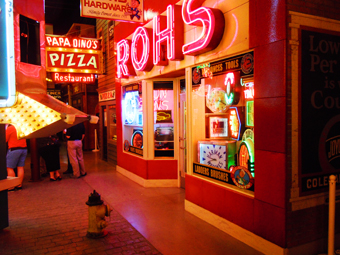 With the opening of the new American Sign Museum on June 23 this year, museum founder Tod Swormstedt achieved one of his dreams. As I walked past the brightly lit exhibits, I thought about what Napoleon Hill, author of Think and Grow Rich, had said: “What a man can conceive of and believe in, he can achieve.”
With the opening of the new American Sign Museum on June 23 this year, museum founder Tod Swormstedt achieved one of his dreams. As I walked past the brightly lit exhibits, I thought about what Napoleon Hill, author of Think and Grow Rich, had said: “What a man can conceive of and believe in, he can achieve.”
As Tod can attest to, achieving your dream is never easy. It takes a clear vision. It takes unwavering belief.
And above all, it takes lots of help and support from great friends.
Planning began five years ago, after Tod had purchased a ninety-three-year-old tool plant in the Camp Washington community of Cincinnati, Ohio. The factory was part of what had been an old manufacturing complex, which is listed in the National Register of Historic Places.
After Christmas that year, Tod had given me a tour of the building. At that time, the property was little more than an old, poorly lit, empty factory. Many of the windows were broken, and you could feel the rush of cold air blowing through the broken panes of glass. The concrete floor of the building was cracked and uneven. And water from the melting snow was dripping from the leaky roof above.
The property was definitely a fixer-upper, but it did have possibilities. As a historic building, it was a perfect location for a museum. The site’s biggest assets, though, were its floor space and its ceiling height.
 The 42,000-square foot property has three-and-a-half times more space than the previous location—enough room to exhibit the museum’s collection of more than five hundred signs. And with twenty-eight-foot-high ceilings, electrical signage that was too large to exhibit in the old facility, like the classic twenty-foot-tall McDonald’s sign, can now be easily accommodated within the walls of the new museum. Plus this location offers the possibility for expansion.
The 42,000-square foot property has three-and-a-half times more space than the previous location—enough room to exhibit the museum’s collection of more than five hundred signs. And with twenty-eight-foot-high ceilings, electrical signage that was too large to exhibit in the old facility, like the classic twenty-foot-tall McDonald’s sign, can now be easily accommodated within the walls of the new museum. Plus this location offers the possibility for expansion.
As we toured the building, Tod pointed from one part of the old factory to another, describing how he envisioned the museum would look when it opened. “Against that wall will be the entire side of barn painted with a Mail Pouch Tobacco ad,” he explained. Earlier that year, Tod had recruited a team of sign makers and friends to help him dismantle a fifty-foot-long Mail Pouch barn. The planks were numbered to aid reassembly in the museum’s future home.
In the center of the museum, Tod explained how they recreated Main Street in the small town of “Signville.” This walk down Memory Lane includes life-size storefronts from a prototypical small American town (including a Marshall Fields, a jewelry story, a barber shop, and a gas station).
Window displays showcase different types of signage from years past. One storefront houses a functional neon tube-bending shop, which would give visitors a window view of a craft of the past. Other areas of the museum feature displays of porcelain signs, dimensional letters, posters, and glue-chipped and gilded glass signs.

Many of his friends in the sign community shared Tod’s vision and helped him in the completion of the new museum. Tod credits David Butler and his wife Suzie with organizing a group of twenty-seven sign artists, who devoted eight, ten-hour days to complete the installation and renovation of the signs on display.
As Tod gave me the tour of the building, I sensed his enthusiasm and commitment to this project. Nothing was going to stop him from turning his dream into reality. With the economic downturn in November of 2008, contributions from corporate donors dried up and delayed the project, which would cost nearly $3 million to complete.
In facing adversity, some wonder why. Tod said why not and persevered as he pursued his dream.
As a result, the new American Sign Museum looks exactly as he described it to me four-and-a-half years ago. Congratulations, Tod!
By Jim Hingst











